Sliding into a Strong Core
Core training is one of the current strength and conditioning trends that has launched a multitude of diverse applications and filled the pages of equipment catalogues with a wide array of assistive paraphernalia.
Practitioners no longer treat the “abs” or the low back region as separate entities of the training culture. They now target and collectively coin (as the core) several of the muscle compartments that emanate from approximately mid-torso to mid-thigh.
Martial arts experts have always taught the importance of developing and controlling the body’s “center,” that basically envelops the core region. A great deal of the influence on the expanding views now being placed on this area can be attributed to the various martial arts disciplines and the increasing popularity of Yoga and Pilates.Photo 1 (anterior) and Photo 2 (posterior) provide general views of the muscular compartments that many fitness professionals include in core training. Obviously, the lateral (side) structures are also tied into the core schematic.
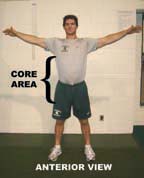
From structural and functional perspectives, some of the major prime-mover responsibilities of the core region include the following:
- Trunk (the all-inclusive area to which the upper and lower extremities attach) forward flexion.
- Trunk extension.
- Trunk lateral flexion.
- Trunk rotation.
- Hip flexion/extension.
- Hip rotation.
- Hip abduction (lateral movement of legs away from the body’s mid-line).
- Hip adduction (medial movement of legs toward the body’s mid-line).
A network of smaller muscles serve in various stabilizing roles.
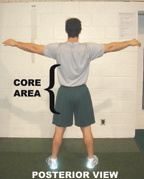 Example: The internal and external intercostals are located between the ribs and have the duties of stabilizing the framework of the rib cage and assisting with respiration.
Example: The internal and external intercostals are located between the ribs and have the duties of stabilizing the framework of the rib cage and assisting with respiration.
There are many ways to attack the core. Entire series of both static poses and dynamic activities can be incorporated either exclusively or collectively with excellent results.
One extremely effective composite of core movements can be performed with the use of a slideboard. While the benefits of slideboard training cross over to all male and female athletes, the ice hockey conditioning coaches have been the frontrunners in developing and promoting it.
Let’s take a look at a handful of the slideboard activities we use on a consistent basis to target the core.
Hip Flexion (Photo 3):
Primary muscles either directly or indirectly engaged: hip flexors, gluteals, and abdominals.
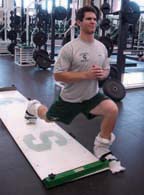 1. Start in a standing position with your left foot next to the slideboard and your right foot on the slideboard.
1. Start in a standing position with your left foot next to the slideboard and your right foot on the slideboard.
2. Slide your right foot/leg backwards in a slow and deliberate manner until you are in a modified lunge position (the back knee should not touch the slideboard).
3. At the mid-range position, tighten your abdominals and right glute, and then slide by “pulling” the right foot/leg forward in a slow and deliberate manner until you return to a standing position.
Perform 10-15 reps with each leg.
Note: Resist the temptation of sliding the back leg forward too rapidly. Doing this will ultimately transfer the brunt of your weight to the front leg, thus reducing the needed tension in the target limb.
Inner Thigh (Photo 4):
Primary muscles engaged: groin and hip adductors.
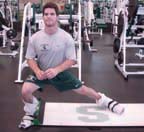 1. Start in a standing position with your right foot next to the end of the slideboard and your left foot on the slideboard.
1. Start in a standing position with your right foot next to the end of the slideboard and your left foot on the slideboard.
2. Slide your left foot/leg laterally (at about a 30-degree angle) in a slow and deliberate manner until you are in a “groin stretch” position.
3. At the mid-range position (depicted in photo), slide the left foot/leg inward in a slow and deliberate manner until you return to a standing position.
Perform 10-15 reps with each leg.
Note: It is important to maintain the tension in the target limb by sliding it back to the starting position in a controlled fashion.
Hip Extension and Hamstring Curl (Photos 5):
Primary muscles either directly or indirectly engaged: hamstrings, gluteals, abdominals, and low back.
 1. Start by lying supine on the floor at the end of the slideboard with only your legs on the board.
1. Start by lying supine on the floor at the end of the slideboard with only your legs on the board.
2. Lift your left foot/leg off the board and hold (Photo 5). At the same time, lift your “hips to the sky” and pull/slide your right foot backwards toward your buttocks in a slow and deliberate manner.
3. At the mid-range position, pause by tightening your abdominals and gluteals, and then return to the starting position.
Perform 10-15 reps with each leg.
Pikes (Photos 6 & 7):
Primary muscles either directly or indirectly engaged: hip flexors, glutes, abdominals, and low back.
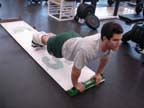 1. Start in a push-up position with your hands at the end of the board (Photo 6).
1. Start in a push-up position with your hands at the end of the board (Photo 6).
2. Tighten the abdominals and “pull your belly-button and hips towards the sky.”
3. Your feet should slide towards your hands, maintaining straight legs resulting in a pike position (Photo 7).
4. Pause momentarily in the mid-range pike position, and then return under control to the starting position.
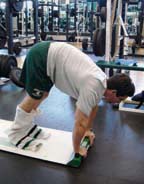 Perform 10-15 reps with each leg.
Perform 10-15 reps with each leg.
Note: Hamstring flexibility – or lack thereof – is indicated by maintaining straight legs and sliding your toes as close as possible to your hands. A closer proximity of feet to hands signifies better hamstring flexibility.
Rotational Leg Slides (Photos 8 & 9):
Primary muscles either directly or indirectly engaged: hip flexor, gluteals, abdominals, obliques, and low back.
Start with both feet together in the center of the board, your hands flat on the ground, and your knees tucked into your chest (Photo 8).
 1. Slide both legs to the right by rolling your hips to the right and straightening your legs. When in this position, stay either on the toes or roll onto the outside of the left foot (Photo 9).
1. Slide both legs to the right by rolling your hips to the right and straightening your legs. When in this position, stay either on the toes or roll onto the outside of the left foot (Photo 9).
2. Slide with control back to the starting position. Pause momentarily to ensure a smooth transition and then continue the slide to your left and mirror the techniques just described.
Perform 15-20 reps to each side.
Final Rep
In the September issue, we discussed some “old school” strength and conditioning concepts and how they could work in concert with many of the proposed new millennium training approaches.
We feel that today’s emphasis on the superficial and deep muscular compartments of the trunk, hips, and proximal thigh/hamstrings is one of the more noteworthy contributions to the field.
Strength training practitioners and coaches of all sports would be well-served by researching this trend with an open-mind.
And to help you get started on your journey, the slideboard offers a very useful, productive avenue for targeting the core.
TIP FROM THE TRENCHES
LEAPing into female physical education programs. Over the years, research has consistently verified that adolescent females are not as physically active enough to lead a healthy lifestyle. Some physical education professionals point to the rigidity of many of the currently employed middle school and high school programs as being the crux of the problem.
A group of researchers recently (2005) designed a comprehensive study to determine if an intervention program named Lifestyle Education for Activity Program (LEAP) could, over time, increase the physical activity levels of the girls in the project.
LEAP is a gender-specific, elective-based design that students can select from a list of activities that the researchers believe the girls would enjoy (e.g., dance, martial arts, aerobics, walking, self-defense, strength-training, etc.) in conjunction with traditional physical education protocols.
The researchers collected data from 2,841 middle-school girls in South Carolina who volunteered for the study. One year later, they were able to collect data from 1,604 of the LEAP girls to determine if there was an increase in vigorous physical activity as compared to non-LEAP students.
The results: Approximately 45% of the girls in the LEAP program continued with vigorous physical activity, as compared to 36% of the girls in non-LEAP – or strictly traditional – physical education programs.
The take-home point from this study is that our ultimate goal of teaching enduring, healthy, lifestyle habits to young girls may be better realized by offering more variety and incorporating a little fun into the process.
Special thanks to former Michigan State hockey captain and current Atlanta Thrasher, Jim Slater, for his assistance with the exercises. For more information on the slideboards we use here at Michigan State, call UltraSlide (800) 259-5356.
Reference: Pate, R. R., Ward, D.S., Saunders, R.P., Felton, G., Dishman, R.K., and Dowda, M., (2005). Promotion of physical education activity among high school girls: A randomized, controlled trial, American Journal of Public Health, 95, 1582-1587.
– Ken Mannie ([email protected])




